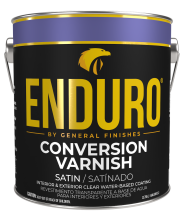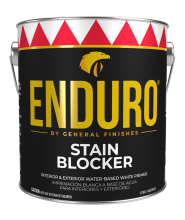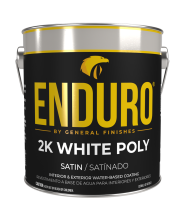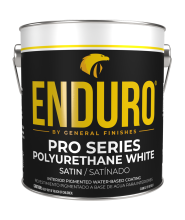Attention email senders! Gmail and Yahoo have implemented major updates to their email deliverability guidelines that determine which emails get tagged as spam, blocked, or bounced with an error. Adhering to these guidelines is vital to helping your emails reach your subscriber’s inboxes and preventing your emails from landing in the spam folder or your domain from being ‘blacklisted.’
Fortunately, Gmail’s compliance enforcement will be gradual and progressive over the next few months, sending temporary errors on non-compliant email traffic which can be used to help you learn what isn’t working and make corrections before getting seriously penalized. Keep in mind, neglecting "required" practices will likely lead to errors, while neglecting "recommended" practices might not cause immediate errors but could still impact deliverability.
Because many of General Finishes' customers run small businesses, we're committed to sharing important updates that can facilitate business success and minimize potential setbacks.
If you haven’t already ensured your email settings are aligned with the new sender requirements, today is the day to start. Read on to learn everything you need to know!
The TLDR summary
While we recommend taking time to read the full guide, here are a few essential points you can act on today:
Who?
The guidelines are recommended for ALL businesses for optimal delivery but sometimes REQUIRED for “Bulk Senders.”
“Bulk Senders” are defined as:
Gmail: “an organization sending more than 5,000 messages per day to Gmail accounts.”
Yahoo: “an email sender sending a significant volume of mail. We will not specify a volume threshold.”
What?
These are the most essential guidelines to have in place today:
Include a clearly visible and easily accessible one-click unsubscribe link within the body of every bulk email.
A bulk email is one email with a general message sent out to more than one contact (e.g. a newsletter, promotional email, etc.). Transactional emails such as automatic password reset emails and 1:1 correspondence excluded.
Bulk Senders: Required
Everyone else: A "one-click" unsubscribe is highly recommended but not required. However, in most countries (including the U.S.A.) ALL commercial emails (those promoting goods or services) are legally required to include a clear and conspicuous way to unsubscribe and a valid physical address for your business, regardless of sender size.
Ensure proper sender domain authentication is in place.
Bulk Senders: SPF, DKIM & DMARC are all required
Everyone else: SPF & DKIM are required, DMARC is recommended. If you do not have a custom domain, SPF & DKIM are likely already handled for you but you are relying on authentication you don’t own. Best practice for deliverability in general is to move over to a custom domain and set up SPF, DKIM & DMARC.
Keep spam rates below 0.1%
It is recommended that all senders (regardless of sending volume) strive to keep their spam rate below 0.1% to increase the likelihood of their emails entering subscribers' main inboxes. Reaching a spam rate of 0.3% puts “Bulk Senders” at risk of getting their domain blacklisted by Gmail and will be ineligible for mitigation.
Note:
-While a 0.1% spam rate can be roughly approximated as 1 complaint per 1000 emails delivered, spam rate is influenced by other factors.
-Reaching 0.3% is not an automatic trigger for blacklisting. Google takes various factors into consideration.
Bulk Senders: 0.3% and 0.1% limits are both applied
Everyone else: 0.3% limit is applied, 0.1% is recommended for deliverability, and keeping spam rates as close to 0 is always ideal
Why should I care?
Gmail and Yahoo make up a significant percentage of email users, making compliance pivotal to ensuring your emails reach a large portion of your subscribers' inboxes.
With the new updates, establishing a solid sender reputation demands ongoing dedication to genuine user engagement metrics beyond opens and clicks in addition to enhanced domain authentication. Chancing permanent blacklisting that could require you to start over from a new domain or endure periods of reduced deliverability, emails bouncing back and spam folder placement is not worth the risk!
Adhering to the requirements demonstrates professionalism, fosters trust, and prioritizes customer safety in an era of increasing phishing attacks and scams.
Why is it changing?
Email security and user privacy are growing concerns, and email spammers are constantly adapting their approaches to break past spam blockers. Increasingly innovative A.I.-powered spam is just one of many challenges Google has aimed to combat with their updated deliverability standards.
While AI spam detection filters remain important, Google is now incorporating sender reputation and user engagement into their assessment.
The new guidelines attack the problem at its source, targeting sender authority and evidence that recipients are happy to receive the content.
The guidelines simultaneously protect GOOD senders by enhancing deliverability, building trust and credibility, avoiding spam filters, and optimizing sender reputation for those who comply.
Who will be impacted?
All of the guidelines outlined in this update have been considered best practice for email deliverability, brand presence and building user trust for many years and would be recommended for all businesses regardless of sending volume.
Most of the new requirements will impact all businesses sending marketing and subscriber messages to a group of people, with additional requirements for “Bulk Senders” which Google defines as “an organization sending more than 5,000 messages per day to Gmail accounts” and Yahoo defines as “an email sender sending a significant volume of mail. We will not specify a volume threshold.” (For all we know Yahoo’s volume threshold could be much lower than 5,000!)
Most of these guidelines do NOT apply to email used for 1:1 correspondence and transactional messages such as password reset messages, reservation confirmations, and form submission confirmations.
---The New Requirements---
For a full list of criteria listed in the Feb 1 requirements, here are the official listings:
Gmail | FAQs
To understand the most relevant criteria for you to keep in check, read on!
Keep Spam Complaints Below 0.1%
[*] This 2024 GUIDELINE is recommended for ALL senders with a particular focus on penalizing “Bulk Senders” who exceed the .3% threshold.
Spam complaints have always mattered, but the February 2024 update introduces a stricter, quantifiable spam rate threshold.
0.1% spam rate:
While not a requirement, it is recommended that all senders (regardless of sending volume) keep their spam rate below 0.1% to ensure content enters subscribers main inboxes. (Learn more)
This metric represents the maximum acceptable spam rate for these senders before facing potential deliverability issues or enforcement actions.
Potential consequences for exceeding the .1% threshold (for all senders regardless of sending volume):
Reduced sending limits: Limiting the number of emails you can send per day.
Lower inbox visibility: Emails landing more frequently in spam folders.
Increased scrutiny from Google: Google paying closer attention to your sending practices.
0.3% spam rate:
Reaching a spam rate of 0.3% puts “Bulk Senders” at risk of getting their domain blacklisted by Gmail and will be ineligible for mitigation. That’s not just the spam folder - that’s blocked. However, reaching 0.3% is not an automatic trigger for blacklisting. Google takes various factors into consideration and will implement a gradual approach to enforcement. Google might restrict sending abilities or limit visibility in inboxes, but account suspension for solely exceeding spam rate thresholds is unlikely.
Reminder: “Bulk Senders” are defined as those sending over 5,000 emails per day to Gmail accounts and an unspecified threshold for Yahoo.
Is spam rate directly correlated with spam complaints?
No. While spam complaints contribute to the spam rate, other factors can also influence it, such as spam filters automatically catching suspicious emails.
Saying .1% equates to "1 complaint for every 1000 emails" can help users put the number of complaints required to meet thresholds into perspective but ignores the variable nature of spam rates. Rates can fluctuate depending on sending volume, audience engagement, and other factors.
What qualifies as a “complaint”?
A spam complaint occurs any time a user clicks “this is spam” or “report spam” in connection with one of your emails, but people sometimes do this as a shortcut to unsubscribing without thinking much of the consequences to a sender! That’s why its more important than ever to make unsubscribe options clear and easy.
Factors to take into consideration:
Forwarding to spam folders: Some email clients automatically report emails forwarded to the spam folder as spam to the provider. While Google doesn't explicitly mention this method, some sources suggest it might contribute to sender reputation scoring.
Marking as spam in webmail interfaces: Users might access webmail interfaces like Gmail or Yahoo Mail to manually mark emails as spam, contributing to sender reputation scoring.
Reporting phishing or malicious emails: If an email is perceived as phishing or malicious, users might report it directly to email providers like Gmail through dedicated reporting mechanisms. This would typically have different consequences than a standard spam complaint.
What happens if I cross the .1% or .3% spam rate threshold?
Anything above a 0.1% rate is considered high and will result in long-term deliverability issues that can take time to repair and could even result in your email client account being suspended. The timeframe for repairing reputation is dependent on the severity of the problem and the efforts to address the problem.
How do I monitor my spam rate?
It’s recommended that you periodically monitor your domain’s sender reputation with Gmail’s Postmaster tools and check your domain status (and any other domains linked to yours) in the Safe Browsing site status page. You’ll get insight into when your emails are marked as spam, why your emails might not have been delivered, if your messages are authenticated, as well as the status of your domain or IP reputation and its impact on message delivery rates.
Factors that impact spam rate (and deliverability):
Spam rate is influenced by a multitude of factors, beyond just user complaints (most of which are covered in this article). Here are some key elements that contribute to your email's likelihood of landing in the spam folder:
Sender Reputation:
Authentication: Implementing email authentication protocols like SPF, DKIM, and DMARC significantly improves your sending reputation and tells receiving servers you're a legitimate sender.
Sending history: Consistent sending practices with low bounce rates and few spam complaints build a positive reputation over time.
Domain reputation: The overall reputation of your domain across all emails sent from it impacts individual email deliverability.
Content & Design:
Relevance and personalization: Sending emails relevant to user interests and expectations reduces the chance of being marked as spam.
Spammy words and phrases: Avoiding words and phrases commonly used in spam emails can prevent triggering spam filters.
Image-to-text ratio: Excessive images with little text can raise spam flags, as legitimate emails typically have a healthy balance.
Design and formatting: Well-formatted emails with consistent branding and clear calls to action appear more professional and trustworthy.
Engagement & List Hygiene:
Open rates and click-through rates: High engagement metrics indicate recipient interest and reduce spam suspicions.
Unsubscribe rates and inactive subscribers: Regularly removing inactive subscribers prevents sending to uninterested recipients, which can raise spam rates.
List acquisition practices: Buying email lists or using unethical methods to collect addresses can damage your reputation and trigger spam filters.
Technical factors:
Sending frequency: Sudden spikes in sending volume can raise red flags, so maintain a consistent and gradual increase if needed.
Sending speed: Sending emails too quickly can be seen as suspicious, so maintain a reasonable pace.
Server health and IP reputation: Ensure your sending servers have a good reputation and are not associated with spam activities.
Additional factors:
Industry and compliance: Some industries have stricter spam regulations, so ensure compliance with relevant laws and best practices.
Targeting and segmentation: Sending targeted emails to specific segments based on interests reduces the chance of generic content triggering spam filters.
Mobile responsiveness: Optimizing emails for mobile devices ensures a good user experience and avoids rendering issues that might raise spam flags.
Next Steps:
Avoid spam complaints:
While you can never have complete control over visitors marking your emails as spam, there are proven methods that can decrease your odds.
While none of the information below is listed as a requirement by Google, these are all tactics that can help:
ALWAYS only send to contacts who have formally opted in to receive YOUR emails.
The higher the perceived value of your email content and the more personalized your content for each audience member’s interests, the more likely they are to remember you and stay engaged.
Enabling the double opt-in confirmation email or captcha at sign-up can ensure only valid addresses and not bot traffic are added to your lists.
Show a clear, easy-to-access unsubscribe button at the bottom portion of the body of the email and the header.
Include a note at the top of the email reminding senders how they were added to your list (your email client can help you set this up). Many people forget they initiated the connection and hit “spam” without realizing the harm it will do to your account.
Automatically schedule a welcome message or a series of onboarding emails after a person signs up for your email list. This will help subscribers remember who you are and why they are getting your emails, and it’s also a timely opportunity to build a deeper relationship off of whatever value proposition motivated them to sign up for your list at a time.
Utilize consistent branding between your website and emails, particularly the page where subscribers join your list and the welcome email they get afterwards.
Email consistently and regularly. If you wait several months between emails there is a chance the recipient won’t remember who you are and why they signed up.
Periodically send messages to confirm that recipients want to stay subscribed.
Avoid introducing sudden email volume spikes if you do not have a history of sending large many emails. Increase the number of emails you send at a slow and steady rate for best results.
Check your status:
Check your domain’s sender reputation with Gmail’s Postmaster tools.
Check your domain status (and any other domains linked to yours) in the Safe Browsing site status page.
1 Click Unsubscribe
[*] This 2024 GUIDELINE is required for “Bulk Senders” but recommended for all businesses.
Gone are the days of multi-step unsubscribe processes!
All “Bulk Senders’” marketing and promotional messages must contain one clearly visible and easily accessible one-click unsubscribe link within the body of the email.
However in the U.S.A. and most other countries, ALL commercial emails (those promoting goods or services) (regardless of sender size) are legally required to include:
-A clear and conspicuous way to unsubscribe.
-A valid, registered, physical postal address for your business.
Body text link requirements:
Clearly visible within the body of the email (it can still be at the bottom like usual)
Easily accessible (not buried in large paragraphs or tiny font)
Resolved in one click (don’t ask someone to “reply” to be removed or require a multi-step process to confirm)
While this rule is technically only required for “Bulk Senders’” accounts (sending more than 5,000 message per day) it’s a best practice that all businesses will benefit from implementing for two reasons:
The easier it is for an uninterested party to unsubscribe, the less likely they are to mark your email as spam out of laziness or frustration instead. As you’ll learn in the next section, it’s more important now than ever to avoid being marked as spam because the threshold for the number of complaints has been lowered before an account sees major deliverability consequences or is blocked.
Now that email engagement is factored in to deliverability, subscribers who don’t open emails or click on content within them could be lowering your engagement rate. Happily letting go of uninterested subscribers is a way to cleanse your list so that it is more heavily concentrated with subscribers who are most interested, most engaged and most likely to buy!
Not all messages require a one-click unsubscribe!
Transactional messages such as password reset messages, reservation confirmations, and form submission confirmations are not required to include an unsubscribe option. (More Information)
Other best practices recommended by Gmail but not required:
Best practice would be also incorporate a one-click unsubscribe header. The header link displays next to the email sender’s email address (e.g. Bloomreach & Litmus).
Provide a link to personalize email preferences in addition to the unsubscribe link. The could allow a customer to say they want to hear from you less often instead of not at all.
Honor unsubscribes within 48 hours of the opt-out.
Next Steps:
If you don’t already know your email provider’s built-in functionality regarding one-click unsubscribes or whether the changes have been applied to your account, we recommend that you contact your email provider’s customer support team and ask!
Sender Domain Authentication
[*] This 2024 GUIDELINE is required for “Bulk Senders” but recommended for all businesses.
Why does domain authentication matter?
Think of domain authentication as showing ID at the door of someone's inbox. Starting in February, "high-volume senders" absolutely need it to get in, and everyone else is strongly encouraged to have it too. It prevents email filters from thinking you're a spammer or an unwelcome sender, increasing the odds your emails land in your subscribers’ inboxes.
Main benefits:
Help protect recipients from malicious messages, such as spoofing and phishing messages.
Help protect you and your organization from being impersonated.
Authenticated domains are less likely to be rejected or marked as spam by Gmail.
What’s required?
SPF or DKIM: REQUIRED for “Bulk Senders” and highly recommended for all senders
DMARC: Highly recommended for all senders
*If you do not use a custom domain (such as those ending in gmail.com) this will already be in place but not custom to your business.
How long do I have to make these changes?
Enforcement for non-compliant senders will start with temporary errors to flag issues starting February 2024 to allow for gradual adaptation and will become stricter with time.
What does it mean?
SPF prevents spammers from sending messages that appear to come from your domain against your wishes.
DKIM is used by receiving servers to verify that the domain owner genuinely sent the message.
DMARC tells receiving servers what you want them to do with messages that don’t pass the SPF or DKIM tests.
If you would like to learn more about each form of authentication, here is a helpful resource from Active Campaign.
Is a custom domain required for compliance?
While using a custom domain isn't strictly mandatory for DKIM, SPF or DMARC, it's highly recommended for optimal email authentication, deliverability, brand integrity, security, and recipient confidence, regardless of sending volume.
Next Steps:
If you use an email service provider, you’ll want to verify that they authenticate your domain’s email with SPF and DKIM. To verify DMARC is in place, contact your domain host.
Mail Tester is a free tool you can use to find out if your domain passes Gmail’s authentication guidelines.
How to use Mail Tester:
Visit Mail Tester and copy the test email provided in the white box (do not leave this page).
Fill out the email opt-in form used most frequently on your website, adding the Mail Tester test email into the email field.
Return to the Mail Tester page and click the button that says, “Then check your score.”
Once you get your Mail Tester results:
Skip down to the AUTHENTICATION tab (third from the top). You will see either green red or yellow check boxes along with instructions for making corrections in areas where your domain missed the mark.
Check out the BLOCKLIST tab (second from the bottom) to get information on whether your account has been marked as spam. If you do show up on a list, click on the flagged link and look for an opportunity to submit your IP address to get yourself removed from the list. (Your IP address is written in italics in gray under the blocklist header and above the list of links.)
If you still are not confident SPF, DKIM and DMARC are all in place or you want to set up email from a custom domain for the first time, we recommend that you contact the customer support team for both your email service provider and domain hosting. Each provider will have its own set of instructions you should be able to find online or by asking customer support.
Send Emails from a Custom Domain
[*] This SUGGESTION is recommended for ALL senders.
While sending emails from a custom domain is not technically required in the February 2024 Gmail or Yahoo updates (regardless of sending volume), it is highly recommended for all senders because email providers tend to prioritize and trust emails from authenticated custom domains, leading to better deliverability and fewer spam filters.
Custom domain emails come from a domain that you own and are likely to look something like, [email protected].
By contrast, a “free email” is any email from a free email provider such as Gmail or Outlook and ends in a generic @gmail.com, @hotmail.com, @outlook.com, @yahoo.com, etc.
Is a custom domain required?
Sending professional bulk emails through free providers like Gmail or Yahoo (not utilizing custom domains) is still allowed (regardless of sending volume) but is not considered a best practice.
Sending one-on-one email correspondence from free providers in professional settings is acceptable but can appear less professional than sending from a custom domain.
Keep in mind:
Unspecified sender volumes: Yahoo doesn't explicitly state their email volume threshold for “Bulk Senders” and experts generally recommend against using free providers for bulk email regardless of volume due to deliverability and reputation concerns.
Authentication Requirements: Domain authentication (like SPF, DKIM, DMARC) is crucial even for free providers to avoid deliverability issues.
Terms of service restrictions: Most free providers explicitly prohibit their use for commercial purposes. Sending business emails, even seemingly one-on-one, could be considered a violation.
Lower sender reputation: Free providers often have lower sender reputations compared to custom domains. This can lead to emails getting flagged as spam and landing in recipients' inboxes less frequently.
Limited functionality: Free providers typically offer fewer features compared to paid business email solutions. This might limit your ability to personalize emails, track results, or integrate with other business tools.
Security concerns: Free providers might have less robust security measures, potentially increasing the risk of data breaches or phishing attempts.
Legal implications: Depending on your location and industry, using free providers for business communication might violate specific regulations or data privacy laws.
Advantages of sending emails from a custom domain:
Brand Recognition and Trust: Custom domains align with your website and establish a consistent brand identity, building trust and recognition with recipients.
Building reputation takes time & won’t all transfer: Regardless of which domain you use, building a good sender reputation requires consistent adherence to good email practices like avoiding spam, providing clear unsubscribe options, and maintaining high engagement rates. The positive track record you worked to build with a free provider will not directly transfer when switching to a custom domain, which could lead to reduced deliverability until your new reputation is established.
Enhanced Authentication: With a custom domain, you fully control DNS records, allowing for seamless implementation and management of SPF, DKIM, and DMARC - crucial authentication protocols for bulk senders.
Compliance Flexibility: Using a custom domain grants more flexibility in complying with DMARC policies, including stricter settings that enhance email security and prevent unauthorized senders.
Advantages of matching your sender domain with your website’s URL:
Brand consistency: Using the same domain for your website and email sender address creates a seamless and unified experience for your audience. This reinforces brand recognition and builds trust, as recipients can easily identify who the email is coming from.
Increased deliverability: Domain alignment strengthens your sender authentication (DKIM and SPF), which plays a crucial role in email deliverability. Well-authenticated emails are less likely to be flagged as spam, leading to a higher chance of reaching your subscribers' inboxes.
Reduced phishing risk: By aligning your domains, you make it harder for phishers to impersonate your brand. Recipients can easily verify the legitimacy of your emails by checking the sender address against your website domain, reducing the risk of them falling victim to phishing scams.
Professionalism: Domain alignment demonstrates attention to detail and professionalism in your email marketing efforts. This contributes to a positive brand image and fosters trust with your audience.
Legal compliance: In some regions, specific regulations require sender domain alignment for email marketing practices. Aligning your domains ensures compliance with these regulations and avoids potential legal issues.
Improved reporting and analytics: When your website and email sender domains are aligned, you gain access to more accurate and comprehensive reporting and analytics across your digital marketing channels. This helps you track the effectiveness of your email campaigns and optimize your overall marketing strategy.
Next Steps:
Don’t already have a custom domain email?
If you own your website domain and pay for hosting, you can contact your hosting plan for instructions on how to buy and set up a connected email address.
If not, you can:
Buy a domain from a provider such as Namecheap.
Set up a hosting from a provider such as Siteground.
Get started sending emails from your domain. A low-cost email management platform is Google Workspace.
Access additional marketing tools (e.g. automations, analytics, etc.) with an email marketing platform such as Active Campaign.
Are free alternatives available?
You can connect your custom domain's email address to a free service like Gmail for sending and receiving emails. However, this might not be ideal for building brand identity and lacks essential features for email marketing.
Free trials are available for some email marketing platforms like Mailchimp or Zoho Mail, offering an entry point for those starting out.
Content Optimized for Engagement
[*] This SUGGESTION is recommended for ALL senders.
Engagement has always been crucial for email deliverability, but Google's February 2024 update has made “true” engagement even more important, with a focus on a wider range of engagement signals.
It's no longer enough to rely solely on high open rates, Google is now placing additional value on content that drives more meaningful interactions from subscribers.
Important engagement metrics:
Clicks: Clicking on links within your email shows deeper engagement than just opening it.
Forwards and shares: When subscribers share your emails with others, it indicates valuable content and boosts engagement.
Scroll depth: How far down recipients scroll in your email suggests their level of interest and engagement.
Unsubscribes, spam reports, and bounces: While low unsubscribe rates are ideal, consistently high rates or frequent spam reports can negatively impact deliverability.
Mobile engagement: As more users open emails on smartphones, mobile-friendly design and optimized viewing experience contribute to engagement.
Written content best practices:
Compelling subject lines: You can write the best email ever but if subscribers don’t open the email, it wont matter.
Avoid using language that triggers spam filters: You can avoid using language that reduces deliverability by running your subject lines through a subject line tester. This free, optional, tool will give you feedback you can use to make informed tweaks before hitting send.
Call to action links: Whenever possible, include a link to take “next steps” (e.g., visit a page on your website, download a guide, make a purchase) that further strategic campaign goals (e.g., building brand awareness, driving sales, etc.) within the body of your email.
Value-rich content: Consistently provide content your subscribers would consider valuable.
Personalization: Tailoring content to specific audience segments can lead to higher engagement.
Engage 1:1: Occasionally encouraging email replies and taking the time to reply back demonstrates active subscriber interest and interaction with your brand.
Content structure best practices:
Avoid broken links: Broken links frustrate users and trigger spam filters. Test all links before sending.
Optimize for mobile: Because a majority of emails are now opened on mobile devices, formatting your emails to display well on mobile devices will result in an improved user experience and could improve engagement rates.
Reduce image size: Large images slow down loading, harming user experience and potentially impacting deliverability. Tools such as this free image compressor tool can help! More information about file size and load times can be found here.
Add alt text: Boost subscriber engagement with clear image alt text. Adding a description of your image within the image alt text will improve engagement from individuals who use a screen reader.
Text layout: Concise paragraphs, bullet points and skimmable text makes reading easier and more enjoyable for your subscribers.
Consistent Branding: Maintaining brand elements builds trust and recognition.
Note: In their email sender guidelines Google states that it does not explicitly track open rates and it is no longer able to verify the accuracy of open rates reported by third parties.
Address Inactive Subscribers
[*] This SUGGESTION is recommended for ALL senders CONSIDERATION.
With email providers now focusing on genuine engagement, unengaged subscribers can cripple your deliverability by dragging down your engagement metrics.
Not unsubscribing inactive contacts can:
Lower engagement metrics: Inactive subscribers drag down your overall open, click, scroll depth, and other engagement metrics. This negatively impacts your sender reputation and deliverability in the eyes of email providers like Google and Yahoo.
Skew data analysis: Including inactive subscribers skews your understanding of actual audience engagement, making it harder to tailor content and campaigns effectively.
Managing inactive subscribers can help you:
Boost sender reputation and deliverability: A more engaged list signals a healthy email program, improving your standing with email providers.
Increase engagement rates: By removing unengaged subscribers, you focus on those who truly value your content, leading to higher open rates, clicks, and conversions.
Maximize ROI: Email marketing services often charge based on the number of subscribed contacts. A clean list ensures your budget reaches the right audience, increasing the return on your email marketing investment.
Tips for maintaining a clean list:
Define "inactive" based on your data: Analyze historical open rates, clicks, and engagement levels to determine the optimal timeframe for identifying inactive subscribers within your audience.
Segment your list: Segment based on demographics, interests, or engagement to tailor your definition of "inactive" and re-engagement strategies for each segment.
Re-engage before unsubscribe: Craft compelling re-engagement campaigns offering valuable content, exclusive deals, or frequency preference options.
Automate unsubscribe workflows: Use email marketing tools to automatically unsubscribe subscribers who meet your inactivity criteria.
Handle bounces: Set up systems to automatically remove recipients with multiple bounced messages or "hard bounces."
Continuously monitor and adapt: Regularly analyze your data and adjust your strategy based on audience behavior and performance metrics.
Note: Email marketing providers such as Active Campaign have tools for automating unsubscribe and reengagement processes, enabling updates in real time without any manual attention or effort.
Combatting Negative Results
Compliance is an ongoing process, but the rewards of reaching your audience effectively and building strong subscriber relationships are well worth the effort.
Proactive compliance is key to success. Google will not provide mitigation for delivery issues for senders that fail to their email sender guidelines.

 Enduro Water-Based Conversion Varnish
Enduro Water-Based Conversion Varnish
 Enduro Water Based Stain Blocker Primer
Enduro Water Based Stain Blocker Primer
 Enduro Water-Based Tintable 2K White Poly
Enduro Water-Based Tintable 2K White Poly
 Enduro Water-Based Pro Series White Polyurethane
Enduro Water-Based Pro Series White Polyurethane
 Hard Wax Oil & Hardener
Hard Wax Oil & Hardener
 Gel Stains
Gel Stains
 Pro Image Flooring Topcoat
Pro Image Flooring Topcoat
 Jen Poly Brushes
Jen Poly Brushes
 Stir Stix
Stir Stix
 Ultraflex Softback Sanding Sponge
Ultraflex Softback Sanding Sponge

